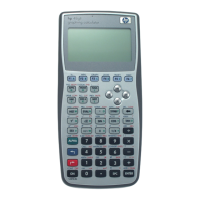3-172 Full Command and Function Reference
STEP
Type: Command Operation
Description: STEP Command: Defines the increment (step) value, and ends definite loop structure.
See the FOR and START keyword entries for more information.
Access: !°
BRANCH START/FOR STEP ( °is the left-shift of the Nkey).
Input/Output: None
See also: FOR, NEXT, START
STEQ
Type: Command
Description: Store in EQ Command: Stores an object into the reserved variable EQ in the current directory.
Access: …µ
STEQ
Input/Output:
Level 1/Argument 1 Level 1/Item 1
obj
→
See also: RCEQ
STIME
Type: Command
Description: Serial Time-Out Command: Specifies the period that SRECV (serial reception) and XMIT (serial
transmission) wait before timing out.
The value for x is interpreted as a positive value from 0 to 25.4 seconds. If no value is given, the
default is 10 seconds. If x is 0, there is no time-out; that is, the device waits indefinitely, which
can drain the batteries.
STIME is not used for Kermit time-out.
Access: …µ
STIME
Input/Output:
Level 1/Argument 1 Level 1/Item 1
x
seconds
→
0
→
See also: BUFLEN, CLOSEIO, SBRK, SRECV, XMIT
STO
Type: Command
Description: Store Command: Stores an object into a specified variable or object.
Storing a graphics object into PICT makes it the current graphics object.
To create a backup object, store the obj into the desired backup location (identified as
:n
port
:name
backup
). STO will not overwrite an existing backup object.
To store backup objects and library objects, specify a port number (0 through 3).
After storing a library object in a port, it must then be attached to its directory before it can be used.
The easiest way to do this is to execute a warm start (by pressing
$& C). This also causes the
calculator to perform a system halt, which clears the stack, the LAST stack, and all local variables.
STO can also replace a single element of an array or list stored in a variable. Specify the variable
in level 1 as name(index), which is a user function with index as the argument. The index can be n
or n,m, where n specifies the row position in a vector or list, and n,m specifies the row-and-
column position in a matrix.
Access: K

